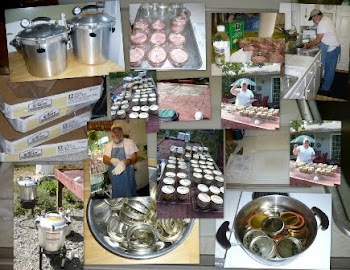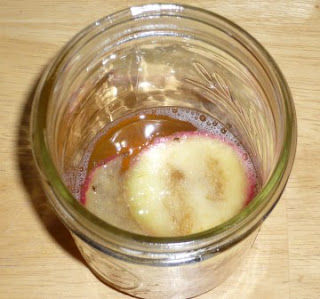- Yes, maybe your Grandmother and your Aunt Mable reused lids and they did not die from eatting their hundreds of jars of canned food.
- Yes, maybe you have read about ever so carefully removing lids and running your finger along the edges to ensure they do not have any dents.
- Yes, maybe you boil them in baking soda or add in a bit of eye of newt to refresh the seal.
So you say, "But Frugal Fraulein, what do I do with all those lids? It seems like such a waste!". Here are some suggestions. First mark used lids with a large X with an indelible marker.
- Use the lids to store leftover food in canning jars in the refrigerator.
- Sore dry goods in canning jars. Take food out of cardboard packaging for longer shelf life and to deter bugs and furry critters. It iss helpful to be able to see inside of jars to see what is hidden within.
- Use jars to store nails and screws and small objects in the shop. Attach the lid and ring to the underside of shelves and simply screw off the jar.
- Make attractive shelves or buy them at the craft store and decorate. Attach lid and ring to underside and insert small toys or candy and give as creative useful birthday party gifts.
- Store sewing goods like bobbins, straight pins, safety pins and thimbles.
- Store spices and dried herbs in canning jars.
- Store dried foods in canning jars.
- Make piggy banks out of canning jars by carefully cutting a slit in a used canning lid. Kids can see how their money is growing.
- Make into a hanging mobile or windchime by punching holes with an awl and painting or stenciling the lids then stringing them up.
- Make craft items with the kids.
- Paint and use for coasters.
- Use lids to mix small amounts of craft paint.
- Use lids to hold beads while beading.
- Paint names of plants on one side and fit between prongs of old forks. Stick forks into garden or potted plants as markers.
- Hot glue onto bambo or treated garden sticks and use as plant or row markers.
- Shingle the roof of a bird house with used lids.
- If TSHTF we might all be reshingling our homes with used lids.
- Store seeds in jars with used lids.
- Make coasters for under furnature legs to protect wooden floors and deep carpet.
- Store small amounts of paint in jars with used lids and take large paint cans to local HAZO House. Dab some of the paint on the top of the lid so colors can be matched at a later date.
- Make holiday lighted decorations by adding led stringed lights to canning jars and decorating.
- Hang used lids off fruit trees to scare off birds.
- Make mixes in a jar and give as gifts.
- Punch holes in a lid and use for bug catching jars or specimen jars.
- Make safety reflectors for driveway by spraying with reflective paint and adherring to post or tree.
- Make kitchen magnets by gluing a small magnet on the back and painting or decoupaging lid.
- Punch with a hammer, awl to make punched tin decorations and attach to the front of a hutch or wooden cabinet for country look.
- Glue a school picture inside and make annual christmas tree ornaments.
- Use them with vaccum sealer to seal dry goods.
- Use as saucers for potted plants.
- Make gift tags. Great to use when giving away canned goods that have domed fabric on top. Make hole in lid and attch with raffia or ribbon.
- Ball, Kerr, Golden Harvest, and Bernardin brands are now manufactored by the same company Jardin Home Brands.
- During WWII in order to save metal for the war effort, the canning jar companies made jars using a 63mm opening. Current lids and rings do not fit these jars. When buying older jars at yard sales beware what size you are buying. I made the mistake of buying some and getting stuck without lids and rings.
- Manufactorers state new lids have a shelf life of up to 5 years and I have read reports of people successfully using lids that were stored up to 25 years. The proof is always in the pudding. If they leave little particles in the pan when they are being heated you know there is a problem.
- Watch out for lids that were stored in hot warehouses that are all stuck together when you take them out of the box. Separating them could cause knicks in the sides and make them unusable.
- If you are unsure about the viability of the lid, discard it and use it for another purpose other than canning.
- Jarden Corporation, maker of Ball and Kerr lids, recommends, “apply bands just until a point of resistance is met – fingertip tight.” If ring bands are screwed on too tightly, the lids will buckle and may forfeit the seal. If bands are not screwed on tightly enough, a seal may not form.
- Jarden Home Brands manufacturer of home canning lids: Ball, Kerr, Golden Harvest, and Bernardin brands follow the same rigorous FDA standards used by the commercial food packaging industry. Like the majority of commercial food packagers using glass jars with metal closures and metal sanitary cans, the coating on our home canning lids is designed to protect the metal from reacting with the food it contains. A small amount of Bisphenol A is present in the coating. The FDA does not limit Bisphenol A in commercially packaged foods, and is aligned with the international scientific community’s position that a small amount of Bisphenol A in contact with “canned foods” is not a health concern for the general public
- Jarden Home Brands knows that product quality and safety play important roles in your purchasing decisions. So, we understand your concern regarding recent reports from Canada about Bisphenol-A (BPA) found in some plastic food contact products. Bisphenol-A is a synthetic chemical compound primarily used to make polycarbonate plastic containers. Please be assured that plastic food storage containers (freezer containers/freezer jars) and plastic food contact articles (cutlery, straws, serving/canning utensils and canning storage caps) marketed by Jarden Home Brands and as provided to our private label companies do not contain Bisphenol-A (BPA).
- There are at least thirty different manufacturers of canning lids in the world.
- One piece lids were not made for home canning.
- Do you have any suggestions for used canning lids?? Enter them below by clicking on Comments.















































